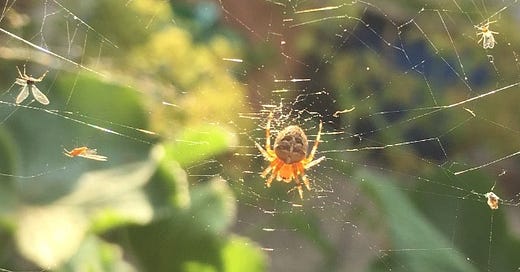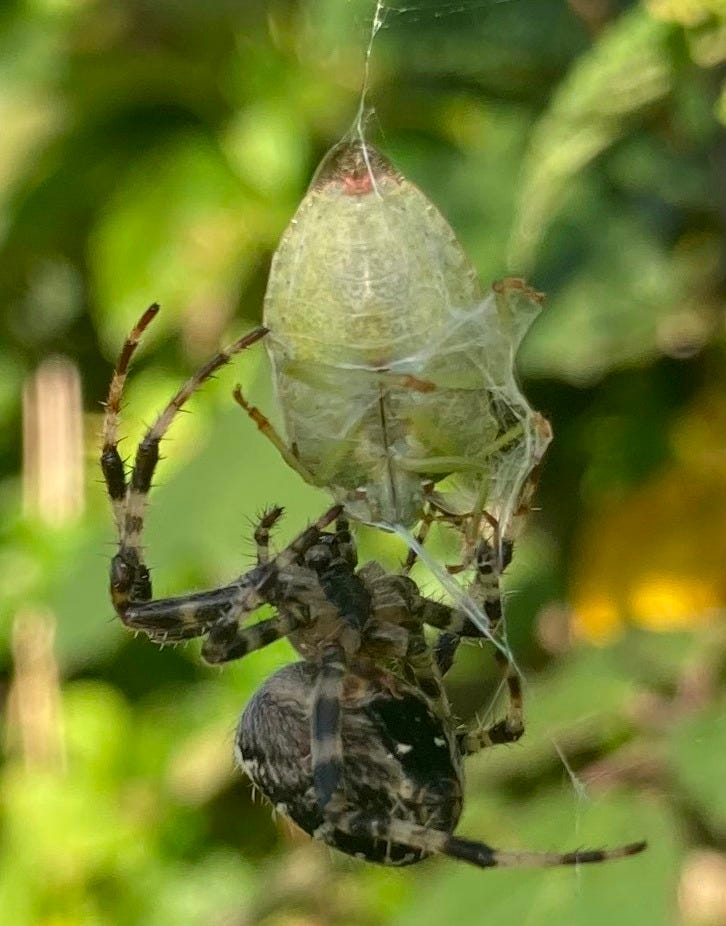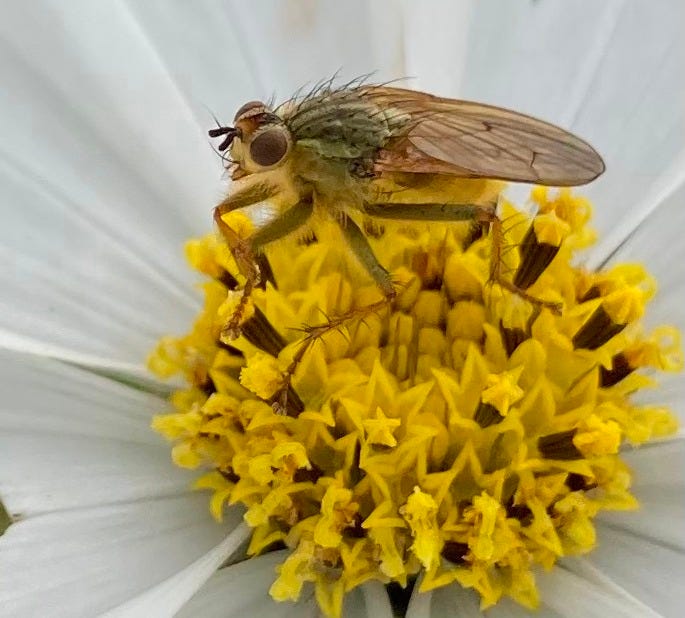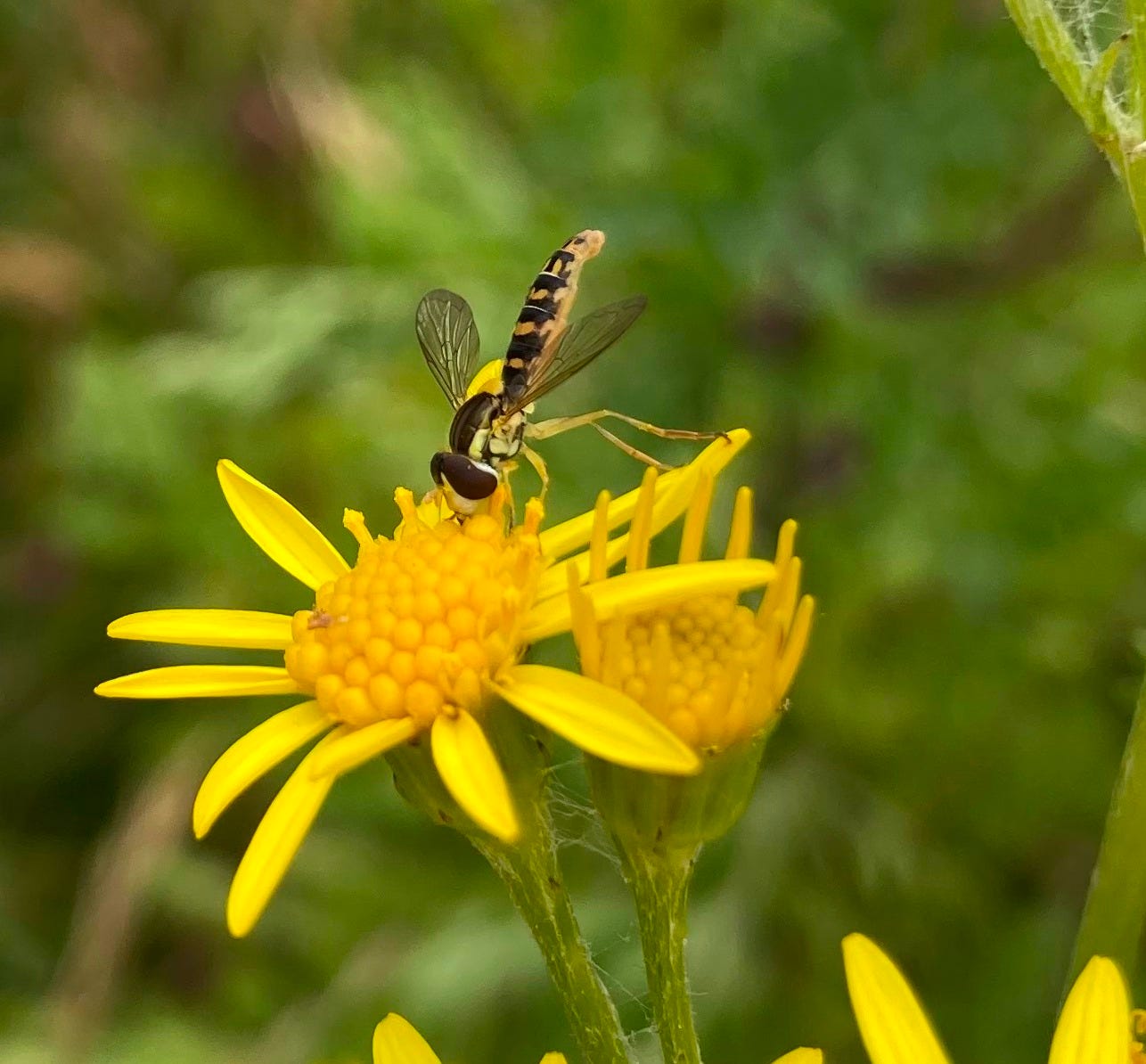There was an old lady...
On spiders and flies, learning to be uncomfortable, and how we can recreate some of the world's most natural processes in our garden spaces.
I have a confession to make: I’m terrified of spiders. Not so much the garden spider (Araneus diadematus), or the daddy-long-legs spider (Pholcus phalangoides), but the big house spiders (Tegenaria spp.), the ones that come into your house in autumn. The ones that run across your living room and up into your curtains so you never want to close them again, the ones you find in the bath, the ones that are big enough to make a noise if they’re on or beneath something that rustles. I would never harm one, and I know that to fling one out of the window is bad, and to even put them outside in cold weather is bad, and so I put them in the shed where they might survive and breed just far enough away from me that I don’t scream and stand on chairs and demand that Emma “get that bloody spider away from me NOW”. Embarrassing isn’t it? For one so committed to nature.
It started as a child. I called the big ones Desmond, after the children’s story Desmond the Dinosaur (because they were as big as a dinosaur, obviously), and I would run next door via the gap in the fence to drink milkshake with my neighbours, Roy and Eve, who were kind and had far fewer spiders in their house than we did. House spiders were a huge part of my childhood, and one of the reasons I’ve never really enjoyed autumn. It’s all too stressful.
As an eight-year-old I walked through a garden spider web by accident and its owner ended up on my face. As a messy teenager I would freeze at the terrifying but all-too-familiar rustle of a Desmond beneath discarded coursework paper. Aged 17, in the middle of the night, I sleepily took a sip of water from my glass only to find a spider writhing around on the surface – its legs helplessly brushing against my nose and lips. It was the last time I slept in bed with my mum. (The next day, when I finally went back into my bedroom, I found the spider, dead in the glass. I could have saved it, and felt terrible. But I couldn’t stop washing my face.)
Over the years I have got used to them a bit. I have tried to get to know them, to understand their needs and habits, to try to think myself out of my phobia. This hasn’t been enough to let them stay in the house but it has been enough to steel myself to get a pint glass and an envelope and creep up on them to transport them from the house to the shed. It’s been enough to accept discomfort and share the greenhouse with the garden spiders and nursery web spiders (Pisaura mirabilis) and be fascinated by what they eat and how they breed – garden spider: millions of babies everywhere! Nursery web spider: carries a sack of eggs with her everywhere! It’s also been enough to register that there there are fewer of them these days, that autumn is less stressful as a result. It’s been enough, not to miss them, but to feel loss about what this means.
This year, for the first time, we’ve had no spiders in the house at all. None. I live in a more urban area than I did as a child and my garden was bigger, then, too. But we all know the reason why there were fewer spiders this year. It’s the same reason I no longer have to cover my food to protect it from flies. The same reason my dad, who used to curse at all the dead insects stuck to the windscreen and headlights of his precious BMW in the 1980s, doesn’t have to wash them off now (and hasn’t had to for 30 years). Spiders eat insects, particularly flies – we all know the old nursery rhyme about the old lady who swallowed a fly, and then a spider to eat the fly, and then a bird to eat the spider, and a cat to eat the bird (“how absurd!”). We all know about food webs and how removing vast amounts of biomass affects everything else around it. There have been so few insects of late – fewer and fewer each year but a real crash in the last 12 months. Insects and the things that eat them: birds, amphibians, hedgehogs, spiders, other insects, are all quietly vanishing on our watch. It’s this, not the spiders named after a fictional dinosaur, that’s terrifying. I’m ashamed.
Flies and spiders are hard wildlife to ‘sell’, compared to bees and butterflies, and I wonder if there would be slightly more of them if people had better attitudes towards them. I realise I’m part of the problem here, and there’s a reason why I’ve never spoken about my fear of spiders before – I don’t want to add to the scaremongering about them. I am terrified of them but I stoically move them to my shed, where they are safe. I know that others stamp on them and spray them, they hoover them up or chuck them out of an upstairs window so they inevitably break their legs. What if spiders had the same associations as bees? Would people like them more? Would we do everything we could to save, not kill them? If spiders were universally loved, would small Kate have run, terrified, from Desmond, to Roy and Eve next door?
Consider flies. There are some 7000 species in the UK, all of which have many different ecosystem functions. But most of us lump them in the same category – shit eaters that spread diseases and should be ‘controlled’. As a child I was taught not to let a fly land on my food, as a teenager I would eat chips in the school canteen, surrounded by posters warning me of the imminent threat of flies vomiting on peas and potatoes. Where there was a fly, there would soon be antibacterial spray, a cursing, a ‘clearing up’. And yet it was the flies themselves that were clearing up – that’s literally their job.
Or it’s the job of some flies, because there are so many of them, they all have different roles. There are the blow flies – two well known species being the bluebottle (Calliphora vomitoria) and the greenbottle (Lucilia sericata) – which are important decomposers – both the adults and larvae clean our streets of excrement, dead bodies and more. There are the yellow dung flies (Scathophaga stercoraria) whose adults are pollinators but who lay their eggs in dung, disappearing it back into the soil. There are hoverflies, some of which eat aphids (nature’s ‘pest’ control if you like) and others which help recycle rotting plant and animal material. Some flies, such as robber flies, eat other flies, and that’s cool too.
I don’t claim to know flies well, and wish I knew them as well as I know bees. But I love meeting new species and getting to know how they live their lives. In summer I met my first semaphore flies (Poecilobothrus nobilitatus). I had made a mini pond to raise a few tadpoles away from the newts, and it had gradually filled up with nettle leaves and other detritus. Suddenly there were flies skitting over the surface. I watched them, closely, as they seemed to be dancing. They were beautiful! Later, fly expert and all-round wonderful person Erica McAlister, told me the males flash their white wing tips at females to flirt with them. I was so happy to have met them while also providing them with a home. And, it seems, somewhere to breed.
I interviewed Erica as part of my podcast series for BBC Gardeners’ World Magazine a couple of years ago, and learned so much, not least that flies are useful at both the larval and adult stage of life. “What do baby bees do?” she asked, teasingly. “NOTHING”. Whereas baby flies are busy removing waste from the environment, before becoming adults that are often pollinators. They’re hard workers, flies, and more of us should know this. Erica and I laughed a lot that day, and sometimes, when I feel blue, I listen to the podcast again because there was so much joy in learning about flies and, in particular, Erica’s relationship with flies. Could we all be a little more Erica?
As a gardener I do what I can for flies. I grow flowers for the pollinators, I leave aphids for the aphid eaters. Every year I give one of my water butts to the rat-tailed maggots, the larvae of the Eristalini and Sericomyiini tribes of hoverfly, that become beautiful species such as the drone fly (Eristalis tenax) and the batman hoverfly (Myathropa florea). I add grass clippings, leaves and other spent plant material, along with twigs that float on the surface so the adults can land and lay eggs, and soon the butt is writhing with hundreds of hoverfly larvae. I also have two ponds (one each in the garden and allotment), where I welcome the attentions of mosquitoes and midges, and leave fox and hedgehog poo for flies to recycle for me.
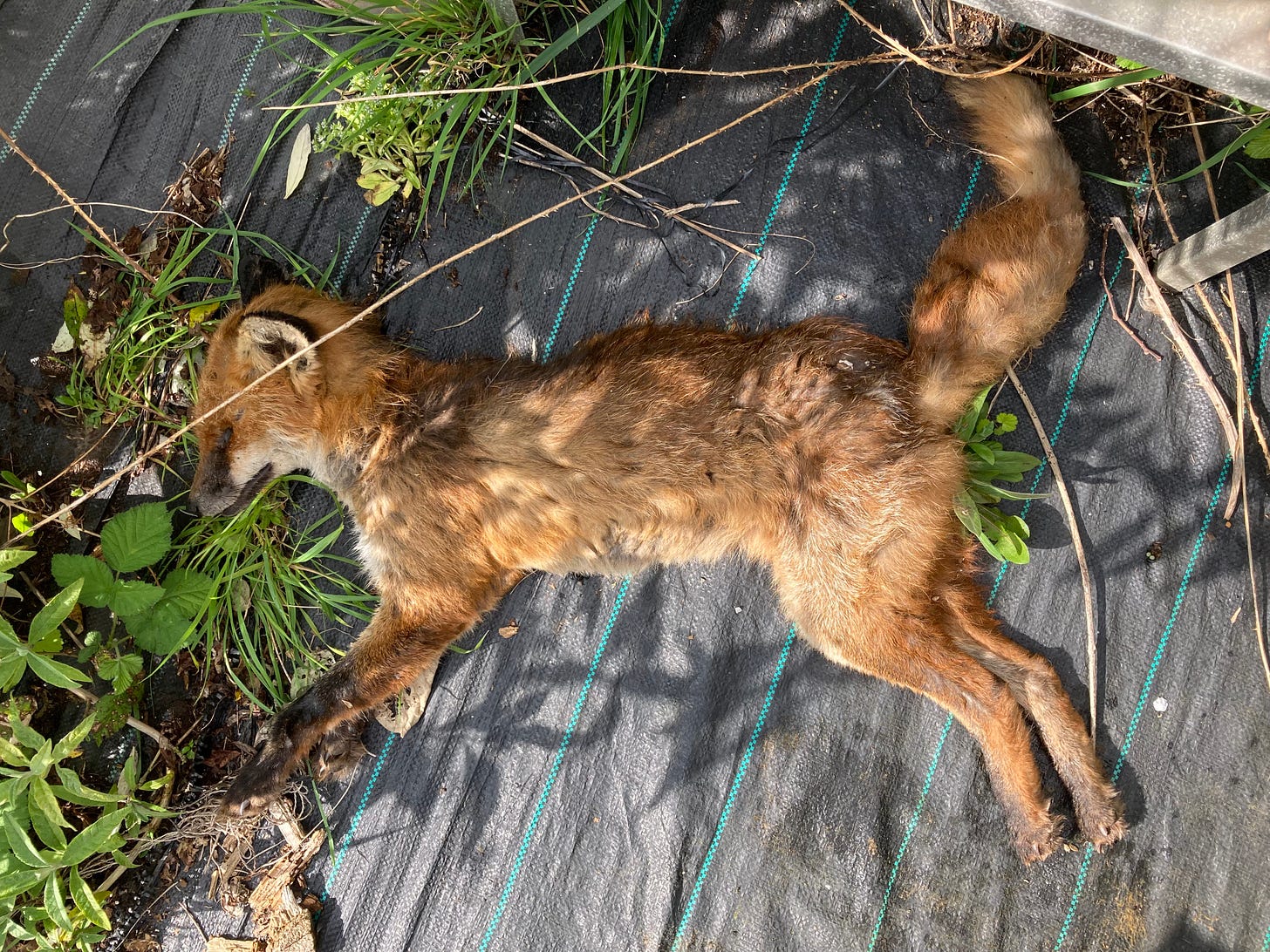
Sometimes I leave dead bodies out, too. A health and safety nightmare, you might think, surely Kate is going to drop dead any minute of some hideous disease caused by proximity to (usually) dead foxes, squirrels and hedgehogs. But I’m still here, and so too are the flies and other species that feast on these carcasses, are the spiders that feast on the flies. If wildlife gardening is respecting and mimicking natural processes, then leaving dead bodies out in the open is one of the greatest mimics of all. I clear flattened hedgehogs and squirrels off roads, I pick up foxes that have been reported to the council for ‘removal’. There’s a spot on my allotment, deep in my nettle patch, where I lay these animals down in their final resting place. They will be visited by birds and beetles, obviously, along with things I couldn’t imagine coming to the soil’s surface to nibble away at fleshy remains. Decomposing processes. But there are flies and there are maggots. Hundreds of them. The carcasses are stripped to bone within a few short weeks, and the spiders have full bellies. It’s the least I can do for the Desmonds I have run away from my whole life.
Another huge thank you so much to my new paid subscribers, who are still making this process more manageable. I am trying to keep my content as accessible as possible, with most posts free for four weeks, but if you would like to support my work then the monthly subscription is as cheap as I could make it. Subscribers get access to the whole archive of posts, plus audio versions of the posts if you’d rather listen to them. And you can grab a signed copy of One Garden Against the World for a fiver.
Wishing all of you a lovely festive season, however you spend it. Don’t forget to get outside and notice things, breathe, move and relax. This time of year can be tricky but there’s a whole world out there to remind us of the bigger picture. Try to get out in it if you can. And if you can’t, give my podcast with Erica a listen, it might wash away those winter blues.
Kate :)
Keep reading with a 7-day free trial
Subscribe to One Garden Against the World to keep reading this post and get 7 days of free access to the full post archives.

